(emTech Section Plus
(emTech) Section Plus is about providing “more” content on emerging technologies—the primary topic of the Xpresso newsletter. This deeper version of (emTech) is provided exclusively for annual subscribers of architosh INSIDER Membership.
Special Feature
We published a special feature in Xpresso #22 titled, “Augmented Intelligence: Digital Blue Foam’s Alternative Approach to Generative Design in Architecture.”
Digital Blue Foam may be an architects’ dream generative design partner, as the company says architects want ‘generative design’ to augment their design process, not take them over.
DO ARCHITECTS REALLY WANT AI TO GENERATE designs from which to choose from? Digital Blue Foam, a software start-up with a growing global footprint, says the answer is “no.”
In some forms of ‘generative design,’ the process begins with loading in the numerical design criteria (something developers can actually do). The architect or developers then respond to dozens if not more generated solutions (options really) that can be further manipulated through various software wizardry, allowing the architect to further fine-tune the results to a ‘Goldilocks’ ideal before shuttling the generated design off to another application—usually a BIM program.
We generate these abstract models, and architects are really good at projecting something into a model that is abstract and seeing possibilities.
This may be a very appealing workflow from the perspective of real estate developers and building asset managers. But architects are hardly rushing to this process. That’s not how architects really want to work, says the founders at Digital Blue Foam.
To read the full story, click here to Xpresso #22. You can subscribe to Xpresso here, it’s free!
The Top Ten Must-Reads
I’ve combed the Internet to find the most interesting, compelling, or controversial stories about the AEC and manufacturing industries, and the social and emerging technological forces at play on both:
1 – AI Regulatory Guidance issued by White House, The White House’s Office of Management and Budget’s AI Regulatory Guidance was released on 17 November 2020. Executive Order 13859 “Maintaining American Leadership in Artificial Intelligence,” assumes that the USA is the global leader in AI technologies. (The White House)
What’s the potential upside? The Executive Order has released a memorandum that outlines policies that can encourage growth in AI, principles of stewardship in AI applications while simultaneously avoiding policies that needlessly hamper innovation and growth. It states, “Where permitted by law, when deciding whether and how to regulate in an area that may affect AI applications, agencies should assess the effect of the potential regulation on AI innovation and growth.” It further stipulates that “promoting innovation and growth in AI is a high priority of the U.S. government.”
While this is positive news for the AI industry, “regulations” are not outlined in the memorandum. Rather, risks to public trusts in AI are communicated; the U.S. government seeks to build trust in AI technologies. And it seeks to “advance American innovation” and therefore make sure “agencies should keep in mind international uses of AI, ensuring that the United States’ regulatory regime does not disadvantage American companies.”
2 – Artificial intelligence is helping lower costs, speed up construction projects. This local news story highlights how AI technologies help construction companies save money on their projects by optimizing construction data to eliminate unneeded equipment and manpower. The story highlights a new company to my ears, ALICE Technologies, which says it can save USD 30 million on a USD 500 million project. (7News)
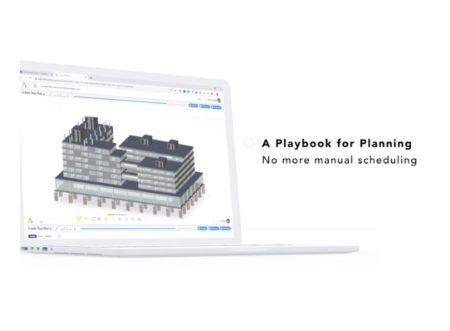
AI optimized construction schedules. ALICE can automatically produce 4D schedules early in the construction planning process. (Image: ALICE Technologies)
What’s the AI tool? ALICE Technologies: artificial intelligence construction engineering, is a Menlo Park, California AI construction software company founded by Rene Markos, a Standford grad with a Ph.D. in Construction Management. ALICE is a construction planning platform powered by AI. With a development office in Prague, the company seems small but growing, counting the likes of Kajima Corp and Takenaka among its heavy-hitter clients.
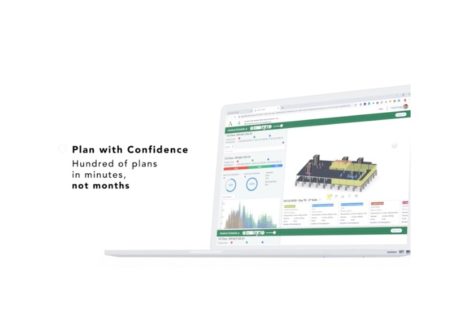
AI is used to produce hundreds of construction plan options in minutes, similar to how AI is being used in early-stage design AI tools like Spacemaker. (Image: ALICE Technologies)
ALICE looks like it uses generative type algorithms to game-play hundreds of scenarios in construction sequence workflows and optimizes outcomes. It also offers the analysis of costs and schedules’ impact to design changes and does much more.
3 – Robots Invade the Construction Site This piece on Wired by Will Knight reviews multiple new robotic applications on construction sites, including a new one to our ears, Canvas, a drywall finish robot. Canvas using lidar, cheap low-cost laser scanners, and computer vision to detect the bare drywall walls and sets about finishing the drywall with a smooth plaster finish. (Wired)
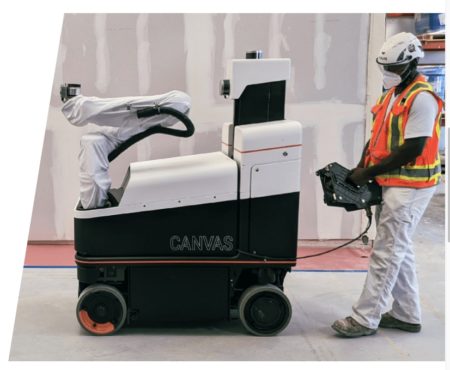
Canvas is a new drywall finishing system robot that saves days on drywall finish construction work. (Image: Canvas)
What is essential in this story? This story runs through several other robot companies mentioned before on Xpresso, including Doxel, Buildots, Boston Dynamics, and its robot Spot, and others. Another aspect of this story is that Kevin Albert, co-founder, and CEO of Canvas, was previously at Boston Dynamics. So we are now seeing individuals from leading robotics companies spin out and create new startups. An IDC report forecast robotics growth in the construction industry will be 25 percent annually through 2023.
4 – Architect Martin Miller: taming complexity with digital tools. This an engaging sit-down with architect Martin Miller, assistant professor of practice in the College of Architecture, Art and Planning (AAP) at Cornell University. (Cornell Chronicle)
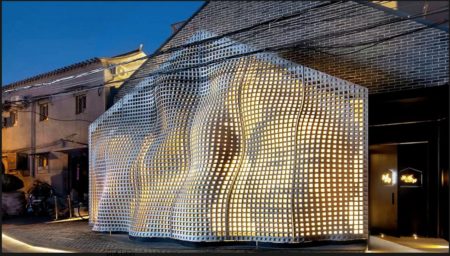
“MaoHaus” in Beijing, China, is an experimental facade that resembles a flowing fabric but is made of concrete. (Image: AntiStatics Architecture)
Any gold nuggets? Yes! Miller is a partner in a Beijing firm called AntiStatics whose origin starts as a criticism of architecture as a fixed idea—”of existing mantras, manifestos, and ideas”… The firm is doing innovative work worth looking at like MaoHaus above in the image.
5 – Biden is expected to spur the growth of the smart city tech market. This report says that Frost & Sullivan predict USD 2.46 trillion of business opportunities in smart cities technologies by 2025. Spending on smart city technologies is expected to grow at a CAGR of 22 percent to USD 327 billion by 2025. (SmartcitiesDive)
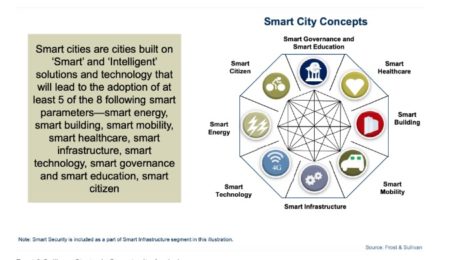
The eight parameters of “smart cities” as defined by this research company. (Image: Frost & Sullivan)
Election ramifications? Frost & Sullivan define a “smart city” as embodying at least five of eight parameters. (see image above), which no city in the world has achieved as of yet. “Under a Biden administration, efforts around smart cities can be expected to accelerate,” said Archana Vidyaskekar, research director of Visionary Innovation Group at Frost & Sullivan.
6 – 8 Smart Cities to Watch in 2020. This article, which oddly lists 8 Smart Cities to watch in 2020, while the article is from this November. Still, the article not only lists 8 interesting cities on this list but explores each city’s “smart city” efforts. (Slate Tech)
What are the 8 Smart Cities to Watch? Aurora, IL, Coral Gables, FL, Colorado Springs, CO, Houston, TX, Jacksonville, FL, Philadelphia, PA, Reno, NV, and Syracuse, NY. It is very interesting to see that not a single “superstar city” is on this list. So some of the interesting things these 8 smart cities to watch include installing smarter infrastructure at roads, bridges, and traffic lights; installing sensors that provide data on pavement temperatures, AI with video data for public safety, EV readiness programs, carbon to EV conversion for city vehicles, smart street lights to reduce energy, resilient plan-to-smart city alignment efforts, wifi on city buses and trains, flood sensors and more.
7 – How The Global Pandemic Became an Inflection Point for Drones. “It’s too early to tell if the pandemic and its impact on in-person business will be the shot in the arm to propel the commercial drone market forward, but companies around the world are rushing to put forth drones that can serve numerous enterprise applications in multiple industries, including construction, agriculture, inspection and food and medicine delivery.” (Forbes)
The Key Takeaways. Global shipments for UAVs for the enterprise alone will reach 2.4 million by 2023, increasing at a 66.8 percent annual growth rate. That’s a healthy growth rate. Amazon missed its estimated 2018 date for Amazon delivery by drone but this past August the company was granted federal approval for its fleet of Prime Air delivery drones.

DroneDeploy is a leader in the drone market covering many industries besides AEC. Mining, Solar, Agriculture, Oil & Gas.
Food delivery (Uber with McDonald’s), Medical delivery (Zipline), and a host of other industrial sectors are all testing up drone deployment. Readers of Xpresso already know about AEC and infrastructure uses for Drones. Think Doxel and DroneDeploy for example.
8 – Rumors: Is AMD working on an ARM-based M1 Rival? “Apple has shaken up the processor industry with the arrival of its M1-powered Macs, offering excellent performance despite being a low-power chip. But could another ARM-based competitor be on its way?” writes Rob Thubron (TechSpot).
Will AMD Enter the ARM Chip Market? A new rumor says AMD will lift the lid on its own version of an SoC (System on a Chip) processor, to rival Apple’s M1. The rumor is interesting because it says AMD will introduce two versions of its secrete ARM chip, one with integrated RAM (the Apple M1 has integrated memory) and one without.
Why this will be important. An AMD ARM-based processor could be a safe hedge for the company, though its own Ryzen X86 compliant microarchitecture has won accolades since its introduction with the company delivering highly competitive processors, which TSMC delivers on a 7nm process with the best products. Delivering an ARM chip could help AMD be perceived as being on the bleeding edge of chip developments, as well as positioning itself well for lower-power chip applications, from efficient ARM-based server applications to edge devices and mobiles. A December Steam Survey shows AMD with 26.91 percent of the CPU market.
9 – Huawei’s 24-core 7nm Kunpeng CPU Allegedly Beats Intel Core i9-9900K. One of the more interesting developments in computing these days is the disruption in the microprocessor field. On the one hand, we have Apple’s disruption and ARM’s disruption, both playing out. Another disruption is happening in China with Huawei. (Tom’s Hardware)

Huawei’s new Desktop PC line up features new and powerful Chinese-made processors based on the ARM architecture. This another index of the rise of ARM architecture and the fall of Intel’s X86 architecture.
The big takeaway? Smartphone maker Huawei Technologies, a company in the general news over US-China relations issues (see: US State Department, “The United States Further Restricts Huawei Access to US Technology,” 17 August 2020) has launched a new brand of desktop PCs, earlier this year back in the late summer. These machines will not use Intel or AMD processors or X86 architecture chips at all, but rather ARM-based processors known as Kunpeng 920, based on ARM’s Neoverse N1 (codename Ares) microarchitecture. The new PC line is striking looking and reminiscent of IBM and Lenovo design language but with a more industrial edge to it.
Kunpeng 920 is a 7nm chip that boasts 24-64 cores that run between 2.4 – 3 GHz. Taiwan Semiconductor Manufacturing Company (TSMC) was at first producing the chip but cut off ties with Huawei due to new US regulations. The article describes more of the machine’s details, including that it doesn’t run Windows either but rather China’s homemade operating system known as Unified Operating System (UOS) a customized Linux variant that works with ARM.
Obviously, “allegedly beats” a very fast Intel chip is just a claim. Part of the issue of testing these machines and this processor is the compatibility issue with its OS with the regular applications and test suites that are common in the West. Huawei Technologies has also placed the Kunpeng 920 processor inside its Atlas 800 server, in fact, two of them. Russian News Agency has a good story on how Atlas servers with Kunpeng 920 chips are saving lives using AI applications and the Atlas 3001 AI Inference card.
10 – A 3D Printed Apartment Building is Going Up in Germany. The ambitions of large 3D printers in the building industry continues unabated. Now a 4,090 square foot building in Wallenhausen, Germany, is being printed. The building is going to be three-stories. (SingularityHub)
Whose has this tech? The project is a joint-venture between COBOD, a Danish firm making large modular 3D printers for the construction company, and a German supplier of formwork and scaffolding systems. COBOD is also now going to be printing the bases of 650-foot tall GE wind turbines. Back to the German 3D printed building, it will be built of a specially developed cement mixture created by HeidelbergCement for 3D printing.
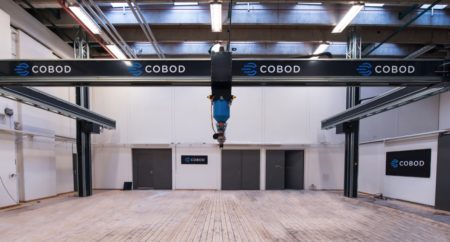
The Danish company COBOD makes the BOD2 gantry system based construction 3D printer with an interchangeable nozzle system. It can be mounted to the foundation of a building or movable concrete pillars. (Image: COBOD / All rights reserved.)
The BOD2 is the company’s second-generation construction printer. It is modular and companies who buy it can select the modular size they need. The MOD2 is 3x faster than the BOD, with an 18 meter per minute print speed. These systems that work on large suspended rail-beams hover over construction sites and lay-down concrete and other materials. In the case of their future partnership with GE, COBOD will 3D printing the bases of even larger GE wind turbines, enabling them to reach higher heights which exposes them to stronger winds. When wind turbines were introduced in the 80s the first generation onshore turbines (20 meters tall) generated a maximum output of 100kW per turbine. By 2017, onshore wind turbines reached 84 meters tall and could output 2MW (2000kW).
Curated content: Emerging Technologies and their potential impact on CAD-based industries
generative design: A Preview of our Spacemaker.ai Talk
Spacemaker.ai is a Norwegian AEC software startup that was recently acquired by Autodesk for USD 240 million in net cash. We have written about the news originally here, then with additional info and insights from Amy Bunzel, Senior Vice President, Autodesk.
Bunzel provided good information not discussed in the news release but I wanted to get deeper on Spacemaker, thus the recent follow-up with them. What follows are some notes from that conversation, while we work on a major Spacemaker feature article coming up. They are pertinent to our Digital Blue Foam feature above and it is interesting to compare both companies. For example, both companies are architect-led and both started with existent problems in architecture practice. This is how Havard Haukeland, the architect, described what led to the founding of Spacemaker.ai.
“I was basically working with the kind of projects that users are using Spacemaker [for] today,” he said, “the early-phase projects, both before users have acquired a site and the years after they have acquired a site, to really find out what to build on the site.”

An image of Spacemaker.ai, showing generated options on the left panel, the main viewport window, and the data palette on the right side. (Image: Spacemaker.ai)
Haukeland told me on our call he was really frustrated that he was not able to deliver what clients really wanted. This was the same message about frustration communicated by Patel about Digital Blue Foam’s practicing architect co-founder, Camiel Weijenberg. So both of these similar companies emerged for a specific set of ‘pain-points’ in architecture practice and the formation of their solutions naturally resemble each other because they both are built upon and reference foundational technologies in the overall constellation of emerging technologies (emTech) in AEC. Namely, machine learning, algorithms-aided design (AAD), or computational design—methods that use algorithms to model based on numerical inputs rather than explicit modeling under the human hand of the computer mouse.
Both companies also arose to address fundamental economic issues. The incremental innovation improvements of traditional modeling, BIM, and CAD tools and the associated design practices (methods of architectural production) are unable to meet demand-side pressures in the market. In simple terms: clients need architects to produce results faster. But not just any results. Clients need better and faster answers at the early stage of the development process.
Here’s one more tidbit from the Spacemaker call. When Havard Haukeland was introduced to eventual co-founder Carl Christensen, a software developer, Christensen initially thought Haukeland must be doing something wrong. He couldn’t believe that was the process architects utilize to answer these early-stage issues.
Special note: Anders Kvale, the third Spacemaker.ai co-founder introduced Haukeland to Christensen.
Further Analysis & Commentary: Both Spacemaker.ai and Digital Blue Foam are emblematic of the next-generation of software that synthetically marries data, AI, or ML algorithms with AAD technology. It appears that input pressures (market demand) are being led by organizations that are further along the adoption cycle of AI and big data technologies than the output organizations. The output organizations include the architects and planners and their established digital tools suppliers. The reason why we hear about frustrations by both sets of founders above, however, likely reflects a matrix of impediments preventing output capacity to match input pressures.
It is not simply that the tools that most architects use can’t provide what building developers want answers to, the entire architecture and planning production apparatus, which consists of AE firm management formation and operations, is ill-prepared to meet the ‘step-change’ productivity demanded. It is imperative that incumbent software leaders take note of the gap between input pressures and output capacity. The problem is most software companies are customer-led (whether on an agile or classic waterfall model) as most businesses are. This gets into central issues around disruption in Clayton Christensen’s famous The Innovator’s Dilemma. If the AEC industry is the digital (ICT era) laggard we all think it is, isn’t this a very potential bad match-up between organizations in industries that are ICT era forerunners and the larger AEC industry? The foreruns are applying market demand pressures that architects cannot match using tools that are a step-change behind (ie: technologies at a 10x min. multiple differential).
This is a very different context than the one for the CAD and BIM transformations. CAD developers in the early 1980s were not responding to market pressures on the demand side requesting productivity improvements at such step-change factors over hand-drafting. Many architects resisted moving to CAD for years because they found CAD rigid and inflexible to their overall processes. Early adoption centered CAD at the working drawings stage while designers continued to meet demand by clients with fast traditional hand rendering and drawing skills. Today, the front end of the process is now being hit by big pressures to not just hit deliverables on faster timelines but deliver data-infused and evidence-based results.
An entire article could be devoted to the industrial sectors and take-up of AI and big data and the relationship to input pressures on output side organizations (AE companies and their tools providers). However, I will scan through some of them in the next (emTech) content below, focused on a new AI chip company.
AI Chip News
SimpleMachines is a new chip company on our radar that was brought to my attention when the CEO reached out to Architosh for a conversation. I was a bit stunned by the reach out, given that Architosh has not published leading-edge information on processors since our information on the AMD GPUs inside the 2013 Mac Pro. (see: Architosh, “The Mac Pro: So what’s a D300, D500 and D700 anyway? We have answers,” 24 October 2013)
Karu Sankaralingham is the CEO of SimpleMachines and he is an academic that has launched a revolutionary new approach to AI-specific microprocessors. I will touch on this AI chip below in brief and then link this conversation with the above one about industrial sectors that are engaging in AI technologies and big data. Companies that take-up AI technologies are speculatively more likely to want to link data and insight into asset operations. This will impact those who provide design and management of those assets (buildings and campuses).

An image of SimpleMachines’ new AI processor. This is the world’s first “algorithm-adaptive” AI chip and is built by TSMC on a 16nm process with packaged HBM2 memory. (Image: SimpleMachines / Architosh)
The new SimpleMachines Mozart AI chip is a break-through “algorithm-adaptive” processor for fast inference and training. It operates with what the company calls a “composable computing paradigm” that in essence means that using the discovery of four course-grained behaviors that compose any algorithm, Mozart can operate faster AI functions across a broad spectrum of AI domains. Their compiler can respond to future algorithms not yet invented while offering dramatic performance.
Further Commentary: An interesting discovery in this conversation with SimpleMachines was that typical AI (machine learning) algorithms have a dramatic overhead on common CPUs (eg: Intel Skylakek core CPUs) and even GPUs. The overhead can be as high as 95 percent with application compute just the balance of 5 percent. Obviously, there are better ratios but not much better. Overhead is a dramatic problem unless an AI chip is built for a specific set of algorithms for tackling certain problems. SimpleMachines’ Mozart is aimed at creating a general and flexible AI compute architecture that has wide computational advantages (high compute, low overhead) over both CPUs, GPUs, and specialized AI chips. You can learn more here and at an upcoming in-depth feature on Architosh.
In the meantime, here are some industrial sectors where AI is being deployed. (1) Automotive (connected and self-driving vehicles, driver assistance), (2) FinTech (financial services), (3) Manufacturing (generative design, factory optimization and floor improvements, robotics), (4) Healthcare (image analysis and diagnosis, drug discovery), (5) Retail (personalization, recommendation engines, demand forecasting), and (6) Telecom and Networking.
Architects, planners, and engineers design assets for all of those industrial sectors. These clients likely are beginning to approach asset design and management borrowing lessons learned from the implementation of AI in their core industry activities. How might these lessons impact architects serving clients in these sectors? Will data from their activities begin to merge with their assets and vice versa? We are seeing it happening now with plant floor optimization. This was an area touched on in the last issue focused on Bentley Systems. (see Xpresso #21, “Bentley’s Now Public—YII20 Highlights and Re-attacking the Architecture Market,” Nov issue, 2020).
What’s Cooking: Future Xpresso Features
We have several possibilities for the January issue of Xpresso but the market is rapidly adjusting to one very important factor in computing and that is Apple’s new M1 Macs. We will have our own M1 powered Mac mini next week and will begin testing CAD and 3D applications on it for performance comparison. We have noted on Architosh that the ODA has released new SDKs with Apple Silicon support.
Editor’s update: Our new Mac mini with M1 processor has arrived! We begin testing it this coming week.
We are really curious to put the M1 Mac through its paces, both at the CPU and GPU level. One thing that we will mention in our SimpleMachines feature coming up on Architosh, is how Apple’s Neural Engine handles AI algorithms versus SimpleMachines.
We look forward to sharing this story in Xpresso #23 in January.
Closing Notes
Another item on my mind is explaining to you all that the Xpresso Index and Glossary are still on the horizon. It has been moved back to Q1, 2021 to align with other Architosh site development updates.
What did Architosh INSIDER members Get?
Member Access—(emTech) Section Plus articles like this one provide architosh INSIDER annual subscribers with more of the content in the (emTech) section of our free monthly newsletter. While this article above features much of the latest issue of Xpresso (#22), there are more and deeper Further Analysis and Commentary sections, more images and inline video.
In addition, the Top Ten Must Reads actually feature 10 curated stories with our commentary and analysis of why we selected them. In Xpresso, only five are provided.
Member Access articles are a premium bonus to annual subscribers that add to the “unlimited site access” nature of your subscription. Thanks for subscribing!





Reader Comments
Comments for this story are closed